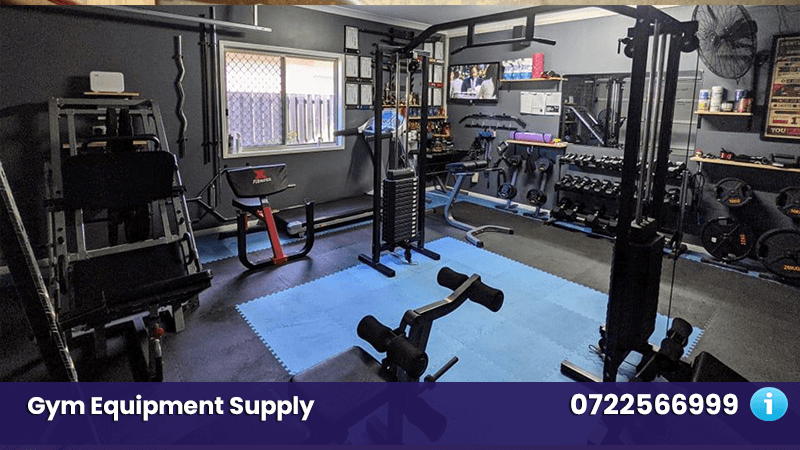Find Gym Installation services and Fitness Equipment Installers in Nairobi, Kenya
Gym Installation in Nairobi and Kenya – Setting up a fitness gym involves a series of steps and considerations to create a functional, appealing, and successful space for exercise enthusiasts. Here is a comprehensive guide to the process:
- Market Research and Planning:
- Conduct thorough market research to understand the demand for a gym in your chosen location.
- Identify your target audience and their fitness needs.
- Develop a business plan outlining your gym’s concept, services offered, pricing strategy, and unique selling propositions.
- Location and Space:
- Choose a suitable location accessible to your target audience, with adequate parking and visibility.
- Consider the size of the space needed based on the equipment, changing rooms, reception area, etc.
- Ensure the space meets zoning laws and building codes.
- Legal and Financial Matters:
- Register your business and obtain the necessary licenses and permits.
- Secure financing or funding for equipment, leasing, renovations, and initial operating costs.
- Consider liability insurance to protect your business.
- Design and Layout:
- Work with an architect or designer to create an efficient floor plan considering the flow of people and equipment placement.
- Design the space for different workout zones like cardio, strength training, free weights, and functional training areas.
- Plan amenities such as locker rooms, showers, reception area, and possibly a juice bar or lounge.
- Equipment Selection and Purchase:
- Research and select high-quality gym equipment suitable for your target clientele and fitness goals.
- Consider factors like durability, maintenance, warranties, and space efficiency.
- Negotiate with suppliers for bulk discounts or leasing options.
- Interior Design and Branding:
- Develop a cohesive branding strategy including logo, color scheme, and signage.
- Create an inviting atmosphere through interior design elements like lighting, mirrors, motivational artwork, and music systems.
- Construction and Renovations:
- Hire contractors or construction professionals to carry out necessary renovations and build the gym according to the approved design.
- Ensure installations meet safety standards and accessibility requirements.
- Staffing and Training:
- Recruit qualified trainers, administrative staff, and cleaning personnel.
- Provide training for employees on gym equipment usage, customer service, and emergency procedures.
- Marketing and Pre-Opening Promotion:
- Develop a marketing strategy including a website, social media presence, flyers, and advertisements.
- Offer pre-opening promotions or membership discounts to generate interest and attract initial clients.
- Grand Opening and Operations:
- Host a grand opening event to introduce the gym to the community.
- Ensure smooth operations by implementing efficient booking systems, cleanliness protocols, and customer engagement strategies.
- Gather feedback from initial members to make necessary improvements.
- Ongoing Management and Growth:
- Monitor finances, membership numbers, and feedback regularly to make informed decisions.
- Adapt and evolve the gym’s offerings based on changing fitness trends and customer preferences.
- Explore opportunities for expansion or additional services to grow the business.
Establishing a fitness gym involves careful planning, attention to detail, and a commitment to providing a positive and safe environment for individuals pursuing their fitness goals.

GYM EGUIPMENT INSTALLATION IN NAIROBI, KENYA | FITNESS EQUIPMENT EXPERTS
A well-equipped fitness gym should offer a diverse range of equipment to cater to various fitness goals and preferences of its members. Here’s a list covering essential categories of fitness equipment commonly found in gyms:
- Cardiovascular Equipment:
- Treadmills: Ideal for walking, jogging, or running workouts, often with adjustable speed and incline settings.
- Elliptical Trainers: Low-impact machines engaging both upper and lower body muscles for a full-body workout.
- Stationary Bikes: Offer options like upright, recumbent, or spin bikes for cardiovascular exercise and leg strengthening.
- Rowing Machines: Provide a full-body workout, engaging the arms, legs, and core muscles.
- Strength Training Machines:
- Selectorized Weight Machines: Target specific muscle groups with machines that have adjustable weight stacks and guided movements.
- Smith Machine/Rack: Allows for controlled barbell exercises with added safety features such as safety catches.
- Cable Machines: Versatile equipment for various exercises using adjustable pulleys and cable attachments.
- Leg Press/Hack Squat Machine: Target lower body muscles for leg strength and development.
- Free Weights:
- Dumbbells: Offer a wide range of weights for diverse exercises targeting specific muscles.
- Barbells: Essential for compound exercises like bench presses, squats, and deadlifts.
- Weight Plates and Benches: Accompany barbells for adjustable resistance and support during workouts.
- Functional Training Equipment:
- Kettlebells: Versatile tools for dynamic movements improving strength, flexibility, and endurance.
- Medicine Balls: Assist in core workouts, functional strength exercises, and rehabilitation.
- Resistance Bands: Useful for stretching, strength training, and mobility exercises.
- Accessory Equipment:
- Bench Press Benches: Adjustable benches for flat, incline, or decline positions during exercises.
- Pull-Up Bars: Essential for upper body strength workouts.
- Exercise Mats: Provide cushioning for floor exercises, yoga, stretching, and core workouts.
- Functional Cardio Equipment:
- Battle Ropes: Engage upper body muscles and improve cardio endurance through dynamic movements.
- Plyometric Boxes: Aid in explosive exercises like box jumps and step-ups.
- Recovery and Stretching Equipment:
- Foam Rollers: Assist in muscle recovery and flexibility by self-myofascial release.
- Stretching Stations: Provide equipment for assisted stretching and flexibility exercises.
- Massage Guns or Rollers: Aid in muscle recovery and alleviate soreness post-workout.
Remember, the selection of equipment should align with your gym’s target demographic, available space, and the fitness trends prevalent in your area. Regular maintenance and ensuring the safety of equipment are crucial for providing a positive and safe workout environment for gym members.

- Advertisements
- Appliances
- Business Services
- Entertainment
- Industry
- Information
- Places
- Property
- Public and Social
- Repair
- Residential & Domestic
- Tradesmen
- Web Design, Nairobi Kenya
- Appliance Repair in Nairobi Kenya
- Washing Machine Repair in Nairobi
- Home


